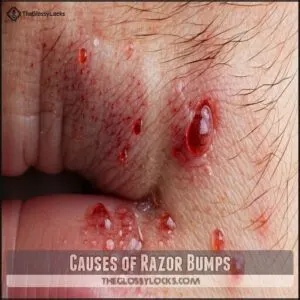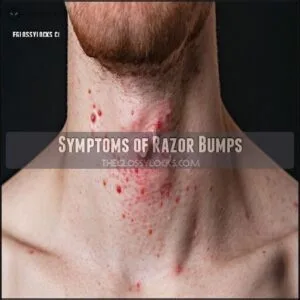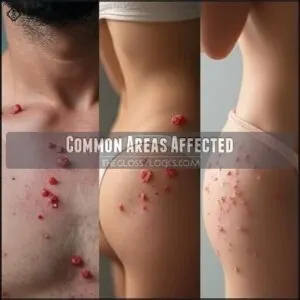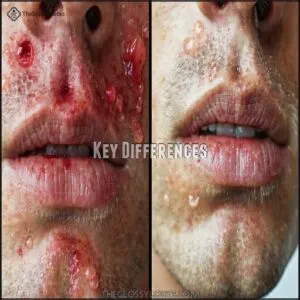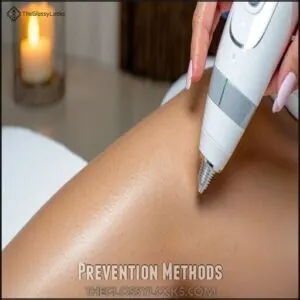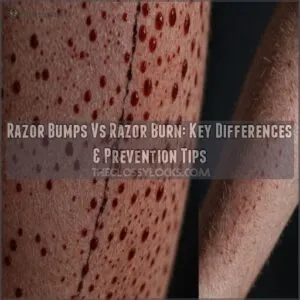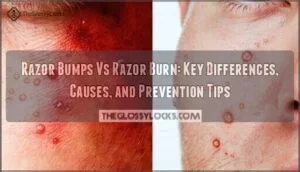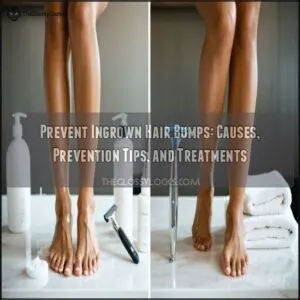This site is supported by our readers. We may earn a commission, at no cost to you, if you purchase through links.
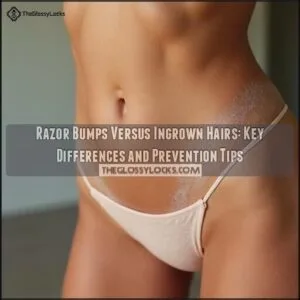
Razor bumps happen when shaved hairs curl back into the skin, causing red, inflamed bumps—especially common on coarse or curly hair.
Ingrown hairs, on the other hand, occur when a hair grows sideways or gets trapped under the skin.
They might feel tender or itchy, with visible hair under the surface.
Both can show up in areas you shave, like your face, legs, or bikini line.
The good news? With the right shaving techniques, exfoliation, and moisturizing, you can keep these irritations at bay and enjoy smoother skin.
Table Of Contents
Key Takeaways
- You get razor bumps when shaved hairs curl back into the skin, causing redness and inflammation, especially in areas like your face, neck, and bikini line.
- Ingrown hairs happen when hair grows sideways or gets trapped under the skin, often showing a visible hair under the surface and feeling more tender.
- Shaving too close, using dull razors, or skipping proper prep like exfoliation increases your risk of both razor bumps and ingrown hairs.
- Prevent problems by shaving with sharp razors, in the direction of hair growth, moisturizing regularly, and exfoliating to keep pores clear.
Razor Bumps Defined
Razor bumps are small, irritated bumps that appear when shaved hairs grow back into the skin.
Small bumps, big irritation—razor bumps happen when shaved hairs turn back into your skin, causing redness and discomfort.
They’re common in areas like the face, neck, and bikini line, especially after shaving too closely or against the direction of hair growth.
Causes of Razor Bumps
Razor bumps, or pseudofolliculitis barbae, are caused by hair strands curling back into the skin after shaving.
Using dull razors, skipping shaving cream, or shaving against the natural direction can irritate skin and inflame hair follicles.
Sensitive skin and coarser hair types increase the risk.
Improper shaving techniques also contribute, leading to razor burn, ingrown hairs, and these uncomfortable, inflamed bumps.
Symptoms of Razor Bumps
When dealing with skin irritation caused by razor bumps, you’ll notice a few telltale signs:
- Redness severity varies, with inflammation around the bumps.
- Bump size is small, often resembling acne or pimples.
- Itch intensity can range from mild to moderate, with possible tenderness.
Pus formation occurs if bumps worsen, and pain duration typically resolves within weeks.
Shaving bumps may escalate if left untreated. A good way to help is to soften facial hair before shaving.
Common Areas Affected
Men often notice razor bumps on the beard area and neck after shaving, while women commonly find them around the bikini line, underarms, and legs.
Curly or coarse hair in these areas increases the chance of hair curling into the skin, causing irritation.
Here’s a quick breakdown:
| Area | Common Issue | Cause | Risk Factor |
|---|---|---|---|
| Beard Area | Razor Bumps | Shaving | Coarse Hair |
| Bikini Line | Ingrown Hairs | Waxing, Tight Clothing | Curly Hair |
| Underarms | Razor Bumps | Close Shaving | Sensitive Skin |
| Legs | Ingrown Hairs | Hair Removal Techniques | Dry Skin |
The table outlines specific areas of the body prone to ingrown hairs and razor bumps, along with their common causes and risk factors, including curly hair and coarse hair.
Ingrown Hairs Explained
Ingrown hairs happen when a hair grows back into your skin instead of rising above it, often causing red, sore bumps.
Ingrown hairs result from hair growing back into the skin, causing red, sore bumps that resemble pimples but feel more tender.
They’re common after shaving or waxing and can be irritated by clogged pores or tight clothing.
Definition and Appearance
Ingrown hairs cause raised, discolored bumps with a visible hair trapped beneath the skin.
These can resemble pimples due to their pimplelike heads, but they’re distinct because of visible hair or a clogged hair follicle.
Affected areas include the beard or bikini line, often causing inflammation and pain.
Their mistaken identities with razor bumps highlight the need for careful observation of bump characteristics, which can help avoid confusion and ensure proper treatment of ingrown hairs.
Causes and Risk Factors
If ingrown hairs frustrate you, look at their root causes.
Shaving techniques matter—shaving too close or against hair growth increases risks.
Curly or coarse hair types also make ingrown hairs more likely.
Skin sensitivity and clothing friction play a role, too.
Poor exfoliation habits clog pores, trapping hair under the skin.
Gentle exfoliation can help free trapped hairs.
Proper hair removal methods and awareness of your hair follicle needs help prevention.
Shaving techniques and gentle exfoliation are key to reducing ingrown hairs, especially for those with curly or coarse hair.
Distinguishing Features
Regarding razor bumps and ingrown hairs, their appearance differences stand out.
Razor bumps, or Pseudofolliculitis Barbae, often look like red, inflamed spots, while ingrown hairs usually reveal a trapped hair beneath the skin.
Pain levels vary—ingrown hairs can feel more tender.
Locations matter too; beard and bikini areas are hotspots for these issues.
Untreated ingrown hairs might lead to folliculitis or scarring.
Key Differences
Razor bumps and ingrown hairs may look alike, but they’re caused by different issues. Understanding these differences helps you choose the right prevention and treatment methods for your skin.
Razor Bumps Vs Ingrown Hairs
Razor bumps and ingrown hairs may seem similar, but they’re not the same.
Razor bumps, tied to shaving, arise when hair curls back into the skin, causing raised, irritated spots.
Ingrown hairs, however, result from any hair removal method, with hair growing sideways under the surface.
Proper blade quality, shaving cream, and exfoliation benefits can prevent hair follicle issues like skin inflammation or irritation.
Similarities and Distinctions
Razor bumps and ingrown hairs share symptoms like redness, irritation, and skin inflammation.
Both stem from underlying causes, such as shaving or hair follicle issues.
However, their appearance differs—razor bumps are clusters, while ingrown hairs reveal trapped strands.
Treatment overlaps with soothing products, but preventative measures, such as proper shaving techniques and exfoliation, help reduce risks.
Understanding these distinctions is key to effective care.
Prevention and Treatment
Protecting your skin from razor bumps and ingrown hairs starts with smart choices.
Shave with clean, sharp razors, and moisturize after using soothing skincare products.
Regular skin exfoliation helps prevent trapped hairs, while home remedies like warm compresses reduce swelling.
For severe cases, seek professional treatments to avoid infection, and focus on bump prevention and scar prevention to keep your skin smooth and healthy.
Prevention Methods
You can prevent razor bumps and ingrown hairs by using proper shaving techniques, exfoliating regularly, and keeping your skin moisturized.
Exploring alternative hair removal methods, like laser treatment, can also reduce the chances of irritation and trapped hairs, which is a key aspect of preventing razor bumps and ingrown hairs.
Proper Shaving Techniques
Preventing razor bumps and ingrown hairs starts with smart shaving techniques. Always shave in the direction of hair growth, not against it, to reduce irritation.
Keep blade sharpness in check—dull razors tug at hair and skin. Skin preparation is key: cleanse and moisturize before shaving.
Cream application guarantees smoother glides, while post-shave care, like rinsing with cool water, soothes irritation.
Regular exfoliation can help with removing dead skin, and is an important part of post-shave care.
Exfoliation and Moisturizing
Scrubbing away dead skin is a game-changer for preventing razor bumps and ingrown hairs.
Use gentle exfoliation, like salicylic acid or glycolic acid, to keep pores clear.
For skin hydration, choose moisturizers with soothing ingredients like aloe vera or tea tree oil.
Apply daily for sensitive skin, focusing on areas prone to irritation.
Effective solutions exist for this problem.
Consistency guarantees smoother, healthier skin with fewer flare-ups, and is a key factor in achieving healthier skin.
Alternative Hair Removal
If exfoliation and moisturizing aren’t solving the issue, alternative hair removal methods can help.
Laser hair removal and electrolysis offer lasting solutions, while waxing and sugaring hair removal are more temporary.
Depilatory creams provide a quick fix but may irritate sensitive skin.
Many people find at-home laser devices convenient and effective. Experiment with these hair removal techniques and products to find one that works best for your skin type and lifestyle.
Treatment Options
When treating razor bumps or ingrown hairs, it’s important to focus on reducing irritation and addressing trapped hair.
Simple steps like using targeted products, exfoliating, and consulting a dermatologist can help you heal quicker and prevent future issues, which is crucial for reducing irritation.
Soothing Razor Bumps
A cooling compress can work wonders to calm irritated skin after shaving.
Razor bumps respond well to soothing solutions like aloe vera and tea tree oil, which reduce inflammation and nourish your skin.
Razor bump creams specifically designed for skin soothing offer targeted relief. Close shaving problems often exacerbate the issue.
Regular, gentle exfoliation also helps clear dead skin cells, preventing further irritation or razor burn while promoting smoother recovery.
Relieving Ingrown Hair Symptoms
Tackling ingrown hairs doesn’t have to be stressful. Focus on softening your skin and helping those trapped hairs break free.
Here’s how:
- Apply warm compresses to reduce irritation.
- Enjoy exfoliation benefits with salicylic acid products.
- Use topical treatments with soothing ingredients like aloe vera.
- Avoid picking to prevent infections.
- Practice good postshave care with alcohol-free moisturizers.
Consider using specialized treatment options for persistent issues.
Medical Consultation and Care
If you’ve got persistent bumps, infection signs, or scarring concerns, it’s time to seek a dermatologist referral.
A doctor consultation guarantees a proper medical diagnosis and a differential diagnosis to rule out other issues.
Medical tests, like STI screening, may be necessary.
Dermatologists offer expert care, from customized treatments to preventative tips, guaranteeing your skin stays healthy with fewer complications.
Frequently Asked Questions (FAQs)
How do lifestyle habits affect skin condition risks?
Think of your skin like a garden.
If you overwork it with harsh habits—like unclean razors or tight clothes—you risk irritation.
Proper grooming, hydration, and gentle care cultivate healthy skin, reducing bumps and irritation.
Are certain skin types prone to these issues?
If you have sensitive or oily skin, you’re more likely to experience issues like ingrown hairs or razor bumps.
Curly or coarse hair types also increase the risk, especially with improper shaving or hair removal techniques.
Can dietary factors influence razor bump severity?
Your diet can affect razor bumps.
Eating anti-inflammatory foods like fruits, veggies, and omega-3-rich options may reduce skin irritation.
Staying hydrated also supports healthy skin, while sugar-heavy diets can worsen inflammation.
What is the role of genetics in hair growth?
Hair growth genetics are like the blueprint you’re born with—factors like ethnicity, hormones, and family traits determine your hair’s thickness, curliness, and growth pattern.
Your DNA influences everything, from hair type to overall texture.
How do hormonal changes impact hair-related irritations?
Hormonal changes can make your skin more sensitive, especially around hair follicles.
Increased oil production or mood-driven stress can worsen irritations like razor bumps or ingrown hairs.
Making proper skincare essential to avoid flare-ups.
Conclusion
Think of your skin as a canvas—razor bumps and ingrown hairs are the small blemishes you can prevent with care.
Knowing the difference between them helps you address each effectively. Razor bumps result from curled, shaved hairs, while ingrown hairs stem from trapped growth.
Focus on proper shaving techniques, regular exfoliation, and moisturization to maintain smoother skin.
If issues persist, explore alternative hair removal methods or seek professional advice.
Tackle razor bumps versus ingrown hairs with confidence and consistency.

